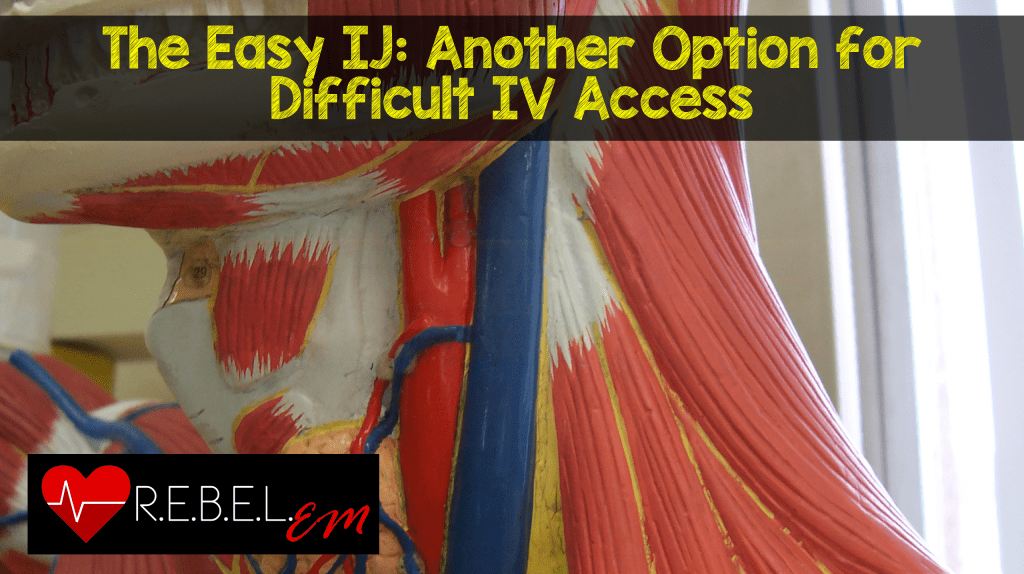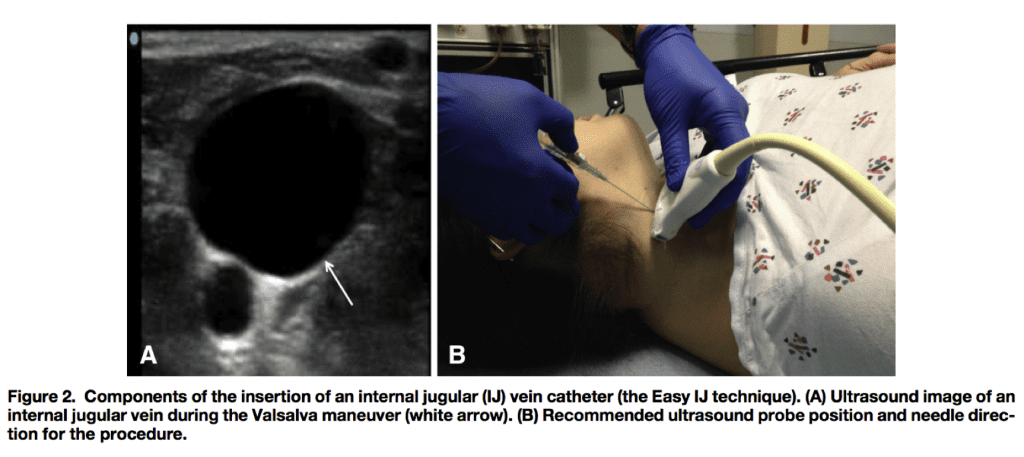
 Background: We have all taken care of patients in whom IV access is difficult due to a multitude of reasons including repeated prior IV access, advanced vascular disease and shock. This often creates delays in patient care, increases ED length of stay, and uses up ED staff that have other patients to care for. Many providers have resorted to using IO access, particularly in critically ill patients due to speed of establishing access. In stable patients, however, this may be a less desirable. Ultrasound guidance has been a great addition in these patients. Ultrasound guided peripheral IVs and external jugular access would probably be the next “go to options” in these patients. The authors of this paper evaluate yet another option: The Easy IJ.
Background: We have all taken care of patients in whom IV access is difficult due to a multitude of reasons including repeated prior IV access, advanced vascular disease and shock. This often creates delays in patient care, increases ED length of stay, and uses up ED staff that have other patients to care for. Many providers have resorted to using IO access, particularly in critically ill patients due to speed of establishing access. In stable patients, however, this may be a less desirable. Ultrasound guidance has been a great addition in these patients. Ultrasound guided peripheral IVs and external jugular access would probably be the next “go to options” in these patients. The authors of this paper evaluate yet another option: The Easy IJ.
What They Did:
- Multicenter, prospective observational study to evaluate the efficacy and safety of the easy IJ in stable ED patients with difficult intravenous access
Definition:
- Easy Internal Jugular (IJ) Access: Placement of an 18 gauge, 4.8 cm, single-lumen catheter (the same catheter used for peripheral access) in the IJ with ultrasound guidance
Materials Required:
- Ultrasound machine with high-frequency linear transducer
- Chlorhexidine
- 4.8cm, 18-gauge single-lumen catheter
- 2 bio-occlusive adherent dressings
- Sterile ultrasound gel
- Loop catheter extension
- Saline flush

Outcomes:
- Initial success rate
- Mean procedure time
- Average pain score
- Number of Skin punctures
- Complications
Inclusion:
- Patients requiring IV access
- Failed attempts at establishing peripheral or external jugular vein access (Including attempts using ultrasound)
- Ability to dilate IJ with Valsalva maneuver
- Ability to sign written consent
Exclusion:
- Hemodynamic instability (HR >150BPM, or MAP <60mmHg)
- Untreated pneumothorax
- Clinical need for triple-lumen venous catheter
Results:
- 83 attempts in 74 patients
- Median body mass index (BMI): 27kg/m2
- Initial success rate: 88% (95% CI 79 – 94)
- Mean procedure time: 4.4 min (95% CI 3.8 – 4.9)
- Average pain score 3.9 out of 10 (95% CI 3.4 – 4.5)
- Number of Skin Punctures:
- One: 75%
- Two: 19%
- Three – Five: 6%
-
Complications:
- Pneumothorax: 0/83 (0%)
- Line Infection: 0/83 (0%)
- Arterial Puncture: 0/83 (0%)
- Loss of Patency: 10/73 (14%) successful lines
Strengths:
- Only multicenter study to date to evaluate the Easy IJ
- Absence of pneumothorax was confirmed by either CXR (82/83) or CT scan (1/83)
- This is an increasing dilemma in the care of EM patients, and gives a nice simple solution, that does not take as long as Central venous access or the discomfort associated with IO in stable awake patients
- No major patient-centered adverse events
- Time of procedure recorded as time from skin prep to confirmation of IV. Many studies start time from when the needle hits the skin.
Limitations:
- Absence of line infection determined by chart review in 55 out of 83 patients. If patients sought care at other facilities this would underestimate the incidence of line infection
- All attempts at access were performed by physicians with >20 previous ultrasound guided line placements, may reduce generalizability if provider is not well versed with ultrasound
- Primary outcome not clearly stated
- Confidence intervals are wide relative to complication rates for the Easy IJ
- Easy IJ catheters were left in for ≤24hrs in this study, therefore infection risk beyond 24 hours cannot be ascertained from this study
- Unstable patients were excluded in this study, therefore cannot draw conclusions of the Easy IJ in unstable patients
Discussion:
- The authors of the paper state that in the limited literature available on this procedure there are no documented cases of pneumothorax, neck hematoma, inadvertent arterial placement, line infection, or site infection
- The procedure itself takes about 5 minutes which is a significantly shorter time than central line placement
Author Conclusion: “The Easy IJ was inserted successfully in 88% of cases, with a mean time of 4.4 min. Loss of patency, the only complication, occurred in 14% of cases.”
Clinical Take Home Point: In stable patients, who have had failed attempts at establishing peripheral or external jugular vein access, the Easy IJ is a rapid method of achieving short-term IV access with no major adverse patient oriented outcomes.
References:
- Moayedi S et al. Safety and Efficacy of the “Easy Internal Jugular (IJ)”: An Approach to Difficult Intravenous Access. JEM 2016. 51(6): 636 – 42. PMID: 27658558
Post Peer Reviewed By: Anand Swaminathan (Twitter: @EMSwami)
The post The Easy IJ: Another Option for Difficult IV Access in Stable Patients? appeared first on REBEL EM - Emergency Medicine Blog.
